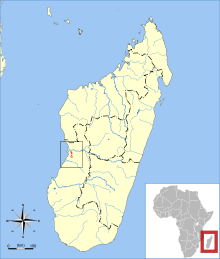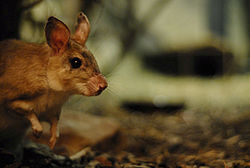- Malagasy Giant Rat
-
Malagasy Giant Rat
Temporal range: Recent
Conservation status Scientific classification Kingdom: Animalia Phylum: Chordata Class: Mammalia Order: Rodentia Family: Nesomyidae Subfamily: Nesomyinae Genus: Hypogeomys
A. Grandidier, 1869Species: H. antimena Binomial name Hypogeomys antimena
A. Grandidier , 1869
Malagasy Giant Rat range The Malagasy Giant Rat (Hypogeomys antimena), also known as the Votsovotsa, is a nesomyid rodent found only in the Menabe region of Madagascar.[1] It is an endangered species due to habitat loss, slow reproduction, and limited range (20 square kilometres north of Morondava, between the rivers Tomitsy and Tsiribihina) [2] Pairs are monogamous and females bear only one or two young per year. It is the only extant species in the genus Hypogeomys; another species, Hypogeomys australis, is known from subfossil remains a few thousand years old.
Contents
Physical description
Malagasy Giant Rats have an appearance somewhat similar to rabbits, though maintaining many rat-like features especially in the face. Males and females both grow to roughly rabbit-size, around 1.2 kg (2.6 lbs) and 33 cm (13 in), though with an additional 20-25 cm (8-10 in) of dark tail. They have a coarse coat which varies from gray to brown to reddish, darkening around the head and fading to white on the belly. They also have prominent, pointed ears and long, muscular back legs, used for jumping to avoid predators. They can leap almost 3 ft (90 cm) in the air, for which reason they are sometimes called Giant Jumping Rats[3].
Reproduction and maturation
These rats are one of the few rodent species to practice monogamy. Once mated, a pair will stay together until one of them dies. On the death of a mate, females tend to remain in the burrow until a new male is found. While males usually wait for a new mate as well, they do occasionally move to live with a widowed female. Females give birth to a single offspring after a gestation of 102-138 days (number observed in captivity) once or twice during the mating season, which coincides with the Madagascar rainy season from December to April. The young are raised by both parents, remaining in the family burrow for the first 4-6 weeks, then increasingly exploring and foraging outside. Young males stay with the family unit for one year before achieving sexual maturity and leaving to find their own burrow. Females do not mature for 2 years and remain with their parents for the extra year. Males are extremely protective of their young. They are known to increase their own predation risk to follow or defend their offspring.
Lifestyle and behavior
Completely nocturnal, the Giant Rats live in burrows up to 5 m (16 ft) across with as many as 6 entrances. Entrances, even those in regular use, are kept blocked by dirt and leaves to discourage predation by the Malagasy ground boa. The other main predatory threat is the puma-like fossa. When foraging, the rats move on all fours, searching the forest floor for fallen fruit, nuts, seeds, and leaves. They have also been known to strip bark from trees and dig for roots and invertebrates. Pairs are highly territorial and both members will defend their territory from other rats. They mark their territory with urine, feces, and scent gland secretions.
References
- Durrell Wildlife Conservation Trust
- Edge of Existence, Zoological Society of London
- University of Michigan Museum of Zoology
- [1]
- ^ Musser, Guy G.; Carleton, Michael D. (16 November 2005). "Superfamily Muroidea (pp. 894-1531)". In Wilson, Don E., and Reeder, DeeAnn M., eds. Mammal Species of the World: A Taxonomic and Geographic Reference (3rd ed.). Baltimore: Johns Hopkins University Press, 2 vols. (2142 pp.). ISBN 978-0-8018-8221-0. OCLC 62265494. http://www.bucknell.edu/msw3/browse.asp?id=13000135.
- ^ S. Sommer & H. Tichy (1999). "Major histocompatibility complex (MHC) class II polymorphism and paternity in the monogamous Hypogeomys antimena, the endangered, largest endemic Malagasy rodent". Molecular Ecology 8 (8): 1259–1272. doi:10.1046/j.1365-294X.1999.00687.x. http://www.blackwell-synergy.com/doi/abs/10.1046/j.1365-294X.1999.00687.x.
- ^ http://news.mongabay.com/2005/0509-rhett_butler.html
Categories:- IUCN Red List endangered species
- Nesomyid rodents
- Endemic fauna of Madagascar
- EDGE Species
Wikimedia Foundation. 2010.
Look at other dictionaries:
Giant pouched rat — Temporal range: Recent Cricetomys emini Scientific classification Kingdom … Wikipedia
Pouched rat — Pouched Rats Temporal range: Early Pliocene Recent Cricetomys emini Scientific classification Kingdom … Wikipedia
Gambian pouched rat — Conservation status Least Concern (IUCN 3.1 … Wikipedia
Southern Giant Pouched Rat — Scientific classification Kingdom: Animalia Phylum: Chordata Class: Mamm … Wikipedia
Kivu Giant Pouched Rat — Scientific classification Kingdom: Animalia Phylum: Chordata Class: Mammalia … Wikipedia
Emin's Pouched Rat — Conservation status Least Concern ( … Wikipedia
White-tailed Rat — For Brachytarsomys albicauda, see White tailed Antsangy. White tailed rat Temporal range: Early Pliocene Recent Conservation status Endangered (IUCN 3.1) … Wikipedia
Major's Tufted-Tailed Rat — Conservation status Least Concern (IUCN 3.1) Scientific classification … Wikipedia
Dormouse Tufted-Tailed Rat — Conservation status Least Concern (IUCN 2.3) Scientific classification … Wikipedia
Daniel's Tufted-Tailed Rat — Scientific classification Kingdom: Animalia Phylum: Chordata Class: Mammalia … Wikipedia


